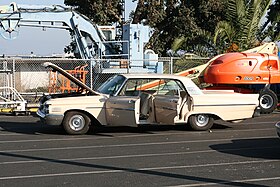Mercury Meteor
| Mercury Meteor | |
|---|---|

1961 Mercury Meteor 800 4-door hardtop
|
|
| Overview | |
| Manufacturer | Mercury (Ford) |
| Production | 1961–1963 |
| Body and chassis | |
| Class |
Full-Size (1961) Mid-size (1962–1963) |
| Body style | 2-door hardtop 2-door sedan 4-door sedan 4-door hardtop 4-door station wagon |
| Layout | FR layout |
| First generation | |
|---|---|
 |
|
| Overview | |
| Production | 1960–1961 |
| Assembly |
Pico Rivera, California Mahwah, New Jersey St. Louis, Missouri Wayne, Michigan |
| Body and chassis | |
| Body style | 2-door sedan 2-door hardtop 4-door hardtop 4-door sedan |
| Related |
Ford Fairlane Ford Galaxie Mercury Monterey |
| Powertrain | |
| Engine | 223 in3OHV straight-6 292 in3Y-block V8 352 in3FE V8 390 in3FE V8 |
| Transmission | 2-speed automatic 3-speed automatic 2-speed manual |
| Dimensions | |
| Wheelbase | 3,047 mm (120.0 in) |
| Second generation | |
|---|---|
 |
|
| Overview | |
| Production | 1962–1963 |
| Assembly |
Dearborn, Michigan Kansas City, Missouri Milpitas, California |
| Body and chassis | |
| Body style | 2-door sedan 2-door hardtop 4-door sedan 4-door station wagon |
| Related | Ford Fairlane |
| Powertrain | |
| Engine | 170 in3OHV straight-6 221 in3Windsor V8 260 in3Windsor V8 |
| Transmission | 2-speed automatic 3-speed automatic 3-speed manual 4-speed manual |
| Dimensions | |
| Wheelbase | 2,934 mm (115.5 in) |
The Mercury Meteor is an automobile that was produced by Mercury from 1961 to 1963. For 1961, the name was applied to low-end full-sized vehicles; for 1962 and 1963, the name was applied to Mercury's mid-sized sedans, in a marketing attempt to appeal to the excitement surrounding the Space Race, before being discontinued. Introduced while Mercury as a marque was in flux, and never a solid marketplace performer in consumer sales, the Meteor remains more a side note than a well known Mercury product.
Initially, Ford used the Meteor nameplate in 1949 when it created a stand-alone marque of vehicles that used Ford bodies trimmed using unique parts for sale specifically in the Canadian marketplace. Meteors were produced and sold in Canada until 1961, and then reintroduced again from 1964 to 1976, after the US model using the name was discontinued.
Canadian 1957 Meteor
In the mid-1950s, Ford executives were convinced by Ernest Breech that, in order to compete with General Motors, the automaker had to meet each sales segment with a unique product. The plan affected Mercury by calling for the marque's completely new platform and body design since World War II in order to differentiate it from Fords, beginning with the 1957 model year.
Historically, Mercury was usually considered a "lower-medium-priced" car, most often compared to Pontiac and Dodge. Under Breech's plan Mercury would move upmarket and compete more directly with Buick, Oldsmobile, Chrysler and DeSoto and the Edsel would take over Mercury's previous role as the lower-medium-priced car and compete more directly with Pontiac and Dodge.
While Breech’s plan could have succeeded in the early 1950s, by the late 1950s the bottom was beginning to drop out of the middle price car market; the 1958 recession effectively rendered Breech’s plan obsolete. Sales of Ford’s Edsel marque were a complete disaster.
Sales of Mercury products failed to reach expected levels, leading to cost cutting decisions beginning in the 1961 model year. Had Robert S. McNamara, then head of the Ford division, had his way, Lincoln, Edsel and Mercury would have been eliminated. Instead, a compromise was made, and beginning in 1961 Ford and Mercury used the basic Ford body shells, and relied upon unique trim elements to differentiate the marques one from another. Edsel, meanwhile, was discontinued after a short run of 1960 models; what emerged as the 1961 Mercury Meteor was initially envisioned as the 1961 Edsel.
...
Wikipedia
